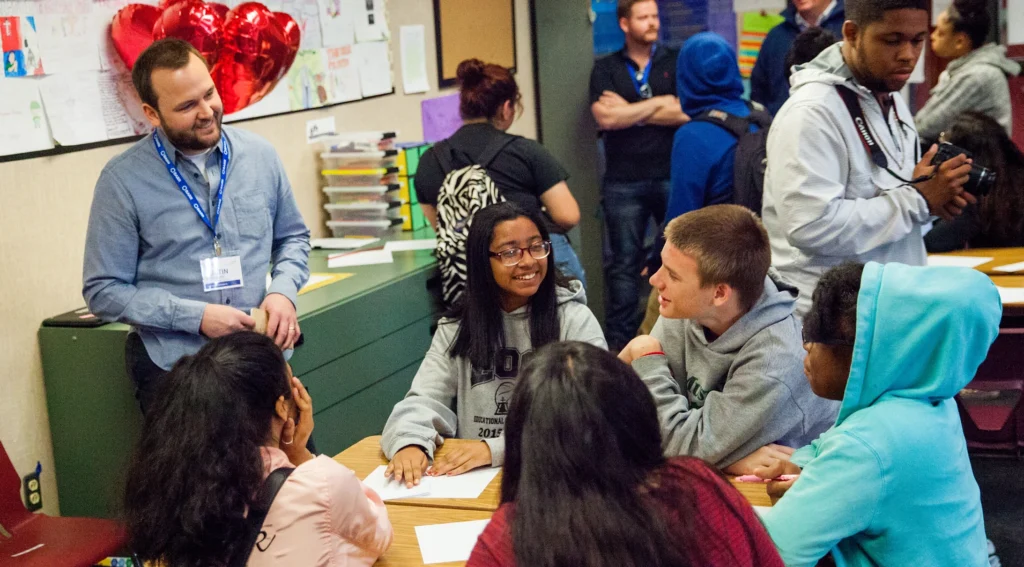
Ali Coalition
For most students, the transition from middle school to high school is daunting. Amidst the inherent difficulties of early adolescence, transitioning to a new school with older students and higher-level courses is challenging on all fronts. What can schools do to support students during this time? With the help of strategic federal investments, the Building Assets-Reducing Risks (BARR) program answered this question with evidence-backed results.
BARR founder Angie Jerabek recognized the challenges facing incoming freshmen. “I developed the BARR model when I was a high school counselor because I had really strong beliefs that the students were incredibly talented and so was the staff,” she said. “Yet we went five years running with half the kids failing.”
Jerabek realized that the traditional school model is not built in a way that connects the dots between students, their talents, and their relationships with teachers. She set out to change that.
The resulting BARR model focuses on eight school-wide and individual strategies that encourage positive student-teacher relationships and greater understanding of student data to address both course-specific and non-academic barriers to student success.
The BARR program began in 1998 at St. Louis Park High School in Minnesota, supported by funding from a Minnesota Department of Human Services State Incentive Grant. After being listed on the Substance Abuse and Mental Health Services National Registry of Evidence-based Programs and Practices, BARR was awarded $4,999,711 in funding from the 2010 Investing in Innovation (i3) grant program (now called the Education Innovation and Research, or EIR, program) to test the model’s effectiveness in other schools – one large, suburban high school in California and two high schools in rural Maine.
The grant supported the BARR program’s ability to replicate the model with a new sample of students and to test its effectiveness in different geographies. The high school in California was willing and large enough to participate in a trial with an experimental design. During the first year of the grant, the program conducted a within-school Randomized Control Trial (RCT), assigning 555 ninth-grade students to either BARR or non-BARR programming.
The results from the RCT were more than promising. Freshmen students who went through BARR programming earned more course credits, higher grade point averages, higher standardized test scores, and a lower rate of course failure compared to their non-BARR classmates. Notably, students who were previously identified as lower achievers significantly outperformed their non-BARR counterparts in overall course credits completed and on standardized tests.
Similar benefits were found by the two schools in Maine that implemented the BARR program. The programming in the original BARR site in Minnesota also continued as a part of the grant program so that the program’s impact could be further tested and documented.
In 2013, the program received an i3 Validation grant of $11,981,926, which funded a validation study. The study found that BARR’s research “met evidence standards without reservation,” the highest possible What Works Clearinghouse rating.
In 2016, the BARR program received a final round of i3 funding — a Scale-Up grant of $20 million. With this funding, researchers conducted a between-school experiment across 66 schools. In this study, teachers and schools were randomly assigned BARR programming, allowing the BARR team to test teacher impact and to further test the program’s effectiveness. The findings were concurrent with previous studies, and the experiment provided exciting data about how the BARR program can increase teacher retention rates.
The funding from i3 was a game-changer in validating these impressive results. Federal investments supported BARR’s ability to prove that the results at one high school were not limited to one local context. Because of the i3 funding, schools interested in adopting BARR programming can now rely on rigorous evidence supporting the program’s efficacy.
Today, BARR is celebrating its 25th anniversary and is a well-established center with programming used by more than 350 schools nationwide in 22 states and the District of Columbia. BARR has not only helped more than 350,000 students experience success in their transition from middle school to high school, but it has also changed how educators understand and approach supporting students. The program is showing how schools can improve student outcomes significantly by increasing transparency around data and student performance and prioritizing relationships between faculty and students. The program has repeatedly proven its ability to increase student engagement and teacher satisfaction, while reducing chronic absenteeism, and more.